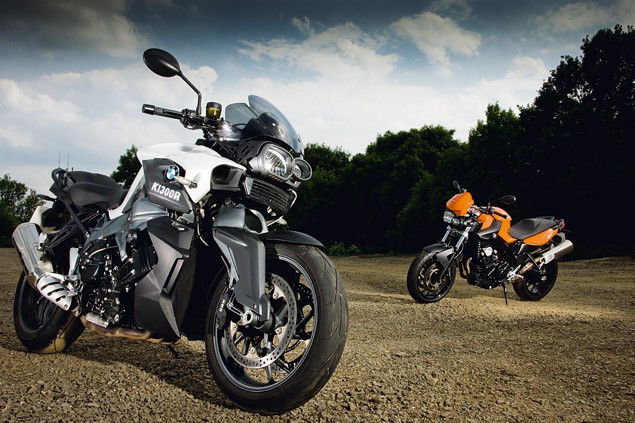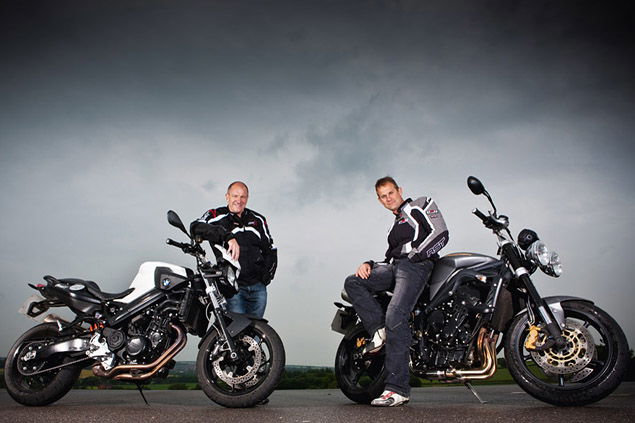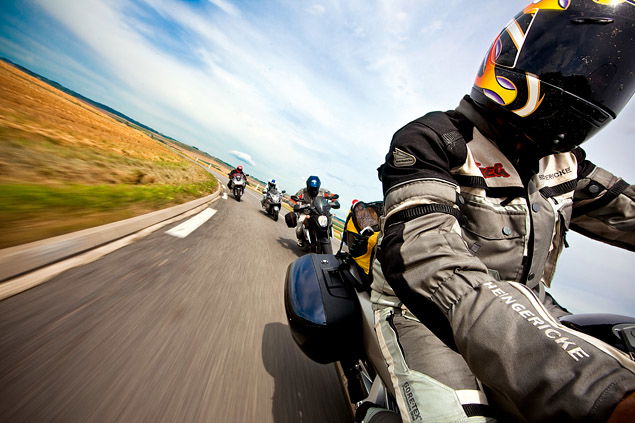Big vs Small: BMW F800R & K1300R
One manufacturer; BMW, one heavyweight; K1300R and one middleweight; F800R. We settle the size issue once and for all, round one...


For as long as there have been motorcycles there’s been two types of streetbike: the middleweight and the heavyweight. In the 1970s it was Kawasaki’s Z650 and decade-defining Z1. Years later Suzuki offered the iconic Bandit in two flavours, 600 or 1200. But which is best?
The Bikes
For the purposes of this investigation the make of bike matters little. The new BMWs are suitably representative examples of their breed but really they could be substituted for a Honda Hornet and a CB1000R, or Triumph’s Street Triple and Speed Triple.
The 800R’s parallel twin may be a fairly unfashionable engine configuration but in every other way it’s on the money for class; 25° head angle (same as a Hornet), 800mm seat height (same as the Hornet and Street Triple) and a wet weight of 203kg (Suzuki claim 202kg for the new Gladius).
But while the F800R blends into a middleweight spec sheet like a grain of sand in the Sahara, the K1300R sticks out like some kind of two-wheeled Great Wall of China, its engineering eccentricity visible from space.
There’s nothing odd about a powerful, four-cylinder engine in a big street bike but a genuine 153bhp and 91 lb/ft of torque gets your attention, as does a quickshifter and quite insane acceleration to a filthy soundtrack.
Then there’s the 1585mm wheelbase (an Aprilia Tuono is a full 17.5cm shorter between the wheels), the duolever front end with its shock, wishbones and cast aluminium fork and, on this lavishly-equipped test bike, ESA electrically adjustable suspension. Only the move to a conventional indicator arrangement stands between your typical Hornet rider and a feeling of hopeless alienation. So it’s a unique beast then, the K1300R, but for our purposes it’s also a suitably extreme heavyweight.
The Ride
Blasting north across a Northamptonshire bathed in perfect Wimbledon weather, I’m pondering what on God’s green Earth could possibly be finer. Yesterday the big K1300R carried me home with unruffled ease, filtering through hours of M25 car park and taking on a couple of empty-ish roundabouts with an aptitude that hinted at much more to come. This morning I’ve found it.
On one of my all-time favourite roads the big-bore street bike is in full effect, braking with incredible composure over the most rutted of tarmac, swinging into corners with an eagerness completely at odds with the bike’s physical proportions (with its mighty inline four engine laid almost face down in a chassis as long as a week in prison, the K1300R looks like it should need tugboats to change direction) and blasting out of them with a fury reserved for a small and very elite bunch of motorcycles, the BMW is bringing on scream-out-loud levels of enjoyment.
That it’s also comfortable and apparently capable of running on pollen (certainly the fuel gauge is refusing to move) is sealing the deal – find the money, lie through your teeth to your insurer and forget flickability, everybody needs the most powerful street bike they can lay their hands on. Human beings need extremes, it shocks us out of our listlessness, and a powerful heavyweight is extreme enough to shock the Titanic to the surface.
The Riders
Representing the typical UK motorcyclist, me. Riding for 12 years, I’ve owned sportsbikes from 400cc to 1000cc and run middleweight street bikes like Honda’s 2007 Hornet. And representing the less experienced Direct Access cadet is a Visordown reader, 23 year-old Ian Stewart. Ian passed his CBT at 17, gained his full licence two years later and has spent the last four years on an eclectic mix of machines, from Chinese off-road 125s through an import-only Honda VT250 to the ZXR750 H1 and 1994 Triumph Daytona he currently tools around on. By his own admission Ian isn’t yet completely at ease with the dynamics of riding a bike but he’s a level-headed, intelligent rider who’s keen to learn – the perfect middleweight street bike buyer then? Let’s find out.
It’s not just me, either. After his first big street bike experience, Visordown reader Ian is impressed. “I got my toeslider down through that left-hander!” he yells over the 1300R’s flat, menacing idle. Hang on a moment Ian, you’re along to represent the relatively inexperienced rider. No offence but the plan is that you find the 1300R a bit much and run to nuzzle your head in the 800R’s much more modest assets. Not a chance. “For a such an angry-looking bike with such a big engine it’s actually a pussycat,” says Ian. “The motor’s really smooth and there’s loads of power but you can ride it gently if you want. It steers really easily too.”
Asked whether, money-no-object, he’d go for a middleweight or a big-bore street bike like the 1300, Ian initially goes for the middleweight option; predictably, you might say. Why? Fear of all that power catching him out, he says. But after another half an hour on the big bike he’s not so sure. “The engine’s so easy to use there’s really nothing to be afraid of. Plus, if you did give it too much in the wet, it’s got traction control. The bigger engine means the 1300R’s more refined for doing the miles than the 800, and you’d never get bored of it. I can imagine after a year or two on the F800R you might be looking for something with a little more power. And the 1300 only feels marginally heavier than the 800.”
The man makes some good points, not least the one about big-distance refinement. Whether you’re comparing Hornets, Triumph’s street bikes or 650 and 1250 Bandits, there’s something about the effortless shove of a big engine that makes big miles easier. Then Ian hits the nail on the head. “My 1200 Triumph takes a lot of input. Even though it’s far more powerful, the K1300R feels so much lighter – I guess that’s 15 years progress.”
Many motorcyclists, arguably quite rightly, adhere to a kind of capacity-based hierarchy. You start with a 125. You ‘work your way up’, perhaps from the 500s so beloved of training centres through a 600 and a 750 to a 1000, and perhaps even beyond – after all, how are you meant to get up hills without a Hayabusa? In years past you did well to respect that hierarchy, not so much for the additional power bigger engines bring but for the extra weight that inevitably accompanied it. But a big engine no longer guarantees big weight. Fully fuelled a Honda Hornet weighs 203.7kg. A similarly tanked up CB1000R is just 7% heavier at 218.2kg. Wet but without fuel, BMW claim the K1300R is just 13kg heavier than the 800R. Little wonder then that Ian’s enjoying the bigger bike’s benefits and discovering precious few drawbacks.
But before we get completely power-crazed and start decreeing 1000cc some kind of absolute minimum in a street bike, let us consider the unique appeal of a well-sorted middleweight. At a junction within striking distance of Triumph HQ at Hinckley, I’m accosted by a man in a flashy new Skoda. He’s taken by the smudge of orange that blitzed him three miles ago and, now that he’s worked out the machine responsible isn’t a Street Triple, he’s perturbed. Turns out he’s a Triumph dealer and, despite himself, he likes the look of the F800R. “Hope it’s rubbish,” he laughs. Sorry fella.
Key to the F800R’s appeal is its infectious eagerness, that and its unrelenting ability to meet almost any challenge you set it. The days of the soggily suspended street bike are behind us and like the Street Triple, Hornet and SV650 before it, the F800R is well up for being pushed. You can move away on tickover and spend all day in the relatively smooth confines of its lower rev range or, with the needle north of 6000rpm, really get a stomp on. The brakes are simply stunning, shot-through with power and communicative feel, the riding position is relaxed yet aggressive and the chassis alive with agility, poise and the composure to go looking for tricky corners into which to stuff its Metzler-shod front end. Quicker to change direction than the 1300, on the same stretches of testing road the 800 feels almost weightless, its inconsequential mass easily bossed with wide bars. It’s the same story whenever agility is important – threading the middleweight through Monday morning London is like skipping stones across a lake. Light and nimble.
So, is the smaller bike more fun? Tough; truth be told it’s different fun. Just as a GSX-R1000’s engine tends to dominate the riding experience where a GSX-R600’s doesn’t, so on a big street bike corners are about waiting for another straight and the chance to stretch the engine. On the 800 the engine’s just enough, providing you’re in the right gear, but the way the chassis nips through them, responding to your every input, keeps you riding until you run out of petrol money. Big bike is about engine, small bike is about rider input. Which one floats your boat more?

